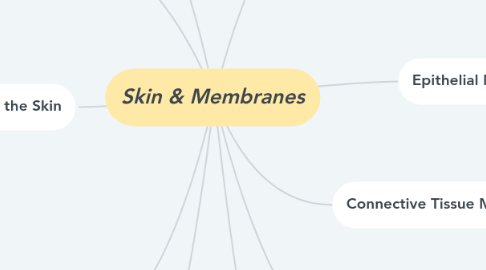Skin & Membranes
da mariah kerr


1. Epidermis
1.1. Superficial, outermost layer of the skin. Relatively thin sheet of stratified squamous epithelium.
1.2. 5 Layers: Stratum germinativum,
2. Dermis
2.1. Deeper of the two skin layers. It is thicker than the epidermis and is made up mostly of connective tissue. Where subcutaneous tissue is found.
3. Disorders of the Skin
3.1. Decubitus Ulcers- pressure sore
3.2. Hives- wheals accompanied by itching
3.3. Scleroderma- autoimmune disease that affects the blood vessels and connective tissues of the skin.
3.4. Psoriasis- silvery, white scalelike plaques found on the skin. Typically on elbows, neck, forehead, and knees.
3.5. Eczema- inflammation of skin that is accompanied by papules, vesicles, and crusts.
4. Skin Cancer
4.1. Squamous Cell Carcinoma- slow growing malignant tumor of the epidermis.
4.2. Basal Cell Carcinoma- begins at the base of the epidermis in the stratum germinativum.
4.3. Melanoma- most serious form of skin cancer.
4.4. Kaposi Sarcoma- Human Herpes virus. Associated with HIV and AIDS
5. Function of the Skin
5.1. Protection
5.2. Temperature Regulation
5.3. Sense Organ Activity
5.4. Excretion
5.5. Synthesis of Vitamin D
6. Skin Infections
6.1. Impetigo-results from staphylococcal or streptococcal infection
6.2. Tinea- ringworm
6.3. Warts- caused by papillomavirus
6.4. Boils- local staphylococcal infection of a hair follicle
6.5. Scabies- caused by the itch mite
7. Epithelial Membranes
7.1. Cutaneous membrane- skin
7.2. Serous membrane- on surfaces within closed cavities.
7.3. Mucous membrane-contains both epithelial layer and connective tissues layer.
8. Connective Tissue Membranes
8.1. Synovial membranes- lines the joint capsules that surround and attach the ends of articulating bones in moveable joints.
9. Burns
9.1. First Degree burn-causes minor discomfort and some reddening of the skin.
9.2. Second Degree burn-all epidermal layer is burned and upper dermal layers are burned. Causes blistering, severe pain, swelling, fluid loss , and scarring are common.
9.3. Third Degree burn- complete destruction of the epidermis and dermis. Tissue death can extend down to subcutaneous tissue.
9.4. Fourth Degree burn- a full thickness burn, extends below subcutaneous layer tissue and reaches the muscle or bone.
10. Skin Glands
10.1. Sebaceous Glands- secrete oil for the hair and skin. Found where hair grows
10.1.1. Sebum- oil that is secreted from sebaceous glands.
10.2. Sweat Glands: Eccrine glands, Apocrine glands
10.2.1. Eccrine Glands- distributed over most of the body's surface. more numerous and widespread. Produce salty watery secretions called sweat.
10.2.2. Apocrine Glands- found primarily in the skin of the armpit and genitals.Secretions are thick, and milky

